[Editor’s note: This article was originally published on May 16, 2018. It was updated on August 27, 2018 and again on December 5 and 24, 2018 to reflect new policy developments. The December updates reflect new solar policy changes in California, Illinois, Kansas, Maryland, Massachusetts, Nevada, New York, Pennsylvania, Virginia, and Washington.]
The solar industry is always dynamic, and keeping track of the latest developments around the nation can be tricky. Although 2018 got off to a rocky start with the federal government’s decision in January to impose a 30% tariff on foreign-manufactured solar components, there have since been a plethora of state-level policy developments that paint a more positive picture for the industry.
Actions by California, New Jersey, New York, and Washington state to commit to 100% renewable or carbon-free energy were especially noteworthy. Nevada also established an ambitious clean energy targets of 50%. California also made the striking decision to require solar installations on new homes. This move—by the world’s fifth largest economy—will help normalize solar technologies and massively expand the solar market.
Additionally, Hawaii’s redesign of utility incentives provides a model for how utilities can benefit from solar growth. Virginia’s major utility took the first steps toward significant solar procurement in accordance with a new state law. Illinois, New York, and Massachusetts updated their solar incentive programs and Maryland offered grant funding for solar-plus-storage projects to improve resilience.
Not all of the state-level actions in 2018 were supportive of solar, however. In particular, rollbacks of net metering may dampen the solar markets in Michigan and Connecticut. Massachusetts and, more recently, Kansas approved demand charges for solar customers. Despite these setbacks, overall 2018 demonstrated that many states recognize the value of solar and other renewable energies and are ready to take action.
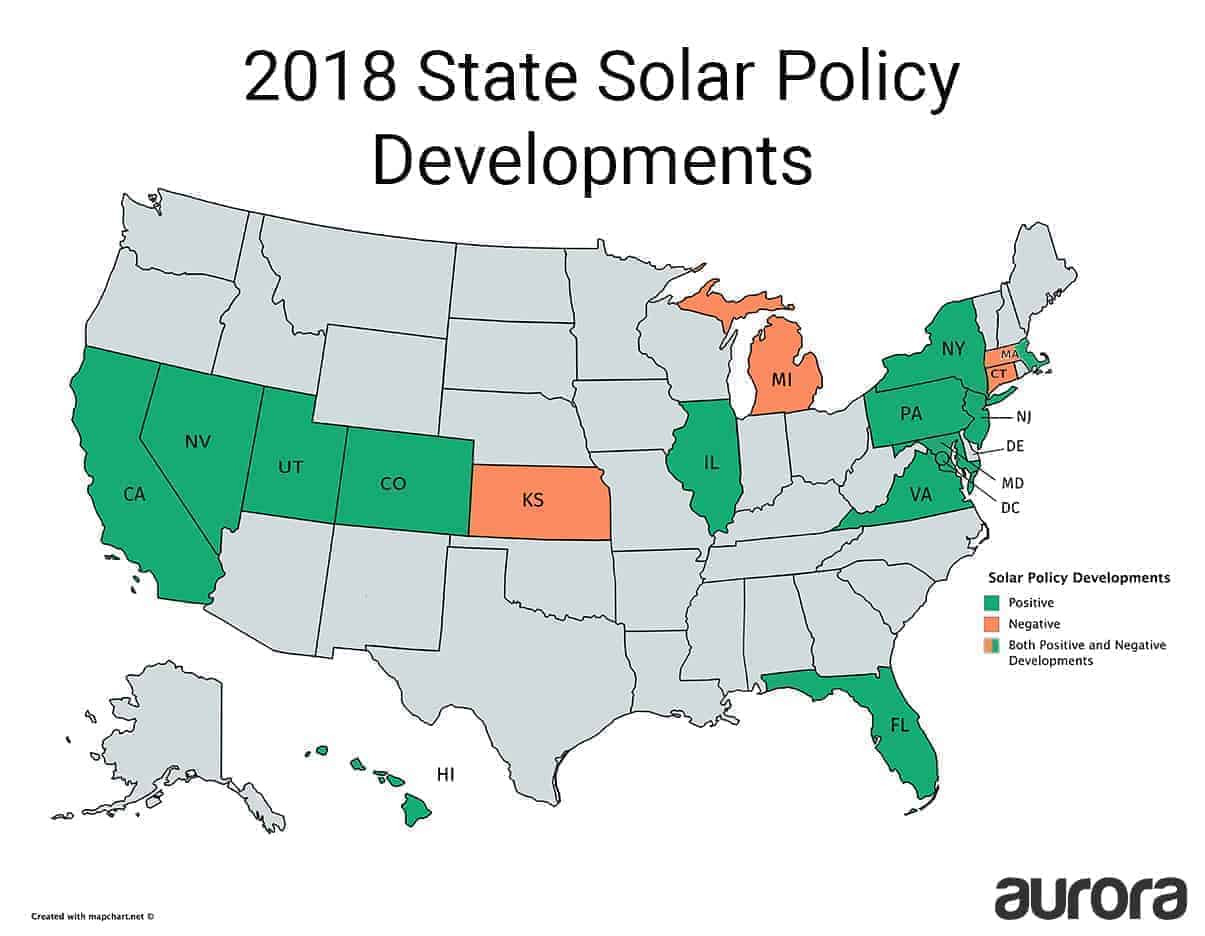
Just interested in a particular state?
Click on one to jump ahead:
California, Colorado, Florida, Hawaii, Illinois, Maryland, Massachusetts,
New Jersey, Nevada, New York, Pennsylvania, Utah, Virginia, Washington
Connecticut, Kansas, Massachusetts, Michigan
(Green indicates positive developments for solar and orange indicates negative ones. Massachusetts had both and appears in both sections.)
The Good News
California
By far the biggest state policy updates, in terms of impacts for the solar industry more broadly, came out of California this year. California mandated that all new homes include a solar installation starting in 2020, as part of a requirement to make homes net zero. Additionally, in September, California Governor Jerry Brown signed legislation requiring all of the state’s energy to be carbon-free by by 2045. As the fifth largest economy, California’s decisions on these issues have massive implications for the growth of solar energy.
The Solar on New Homes Mandate
On May 9th, the California Energy Commission mandated that nearly all new homes have rooftop solar starting in 2020. The changes, part of the state’s newly approved 2019 Building Energy Code, received final approval on December 5th.
The decision will significantly increase demand for solar energy; Greentech Media predicts a 14% increase in total U.S. solar sales over the next four years as a result! It also represents an important shift in making solar energy a new normal for consumers. Resulting industry changes may also contribute to falling costs for California solar installations.
This announcement will spur further growth in the California solar market, which has more installed solar than any other state by a factor of five according to SEIA.
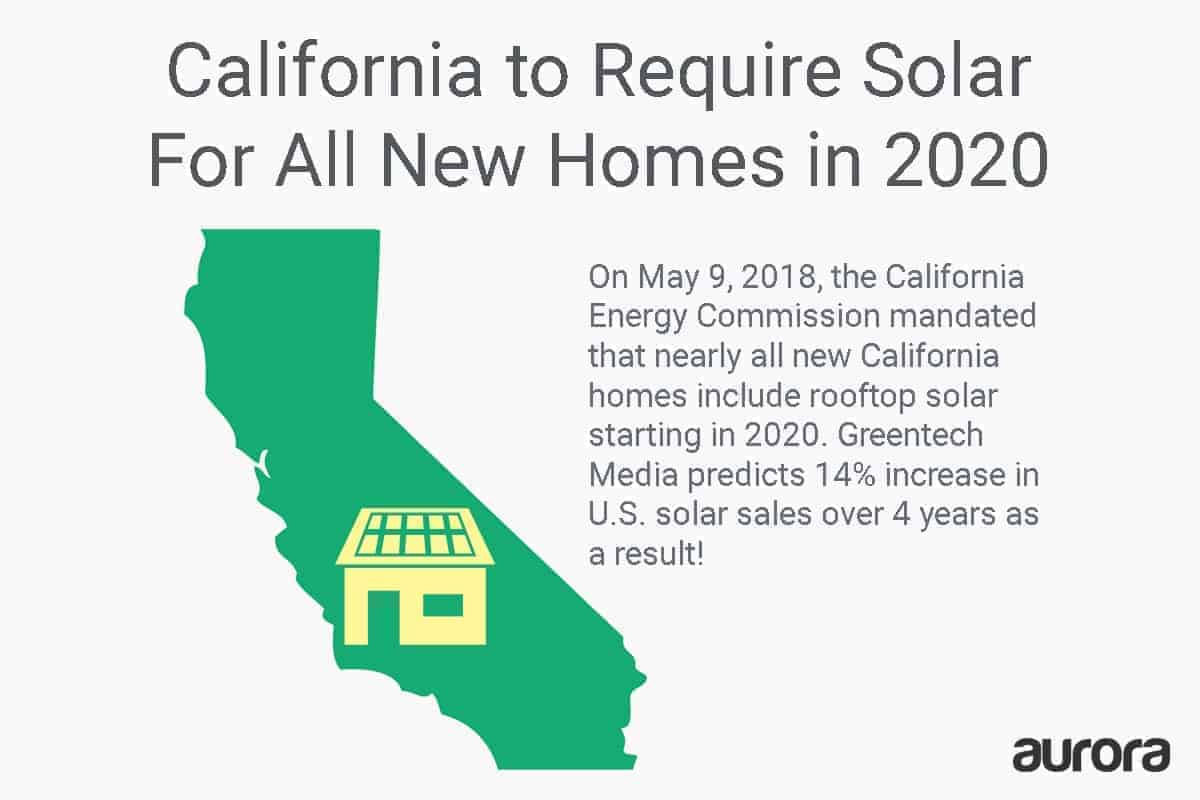
SB 100: Carbon-free Energy for California by 2045
In September 2018, California Governor Jerry Brown signed into law Senate Bill 100 which establishes a target of providing 100% of the state’s electricity from carbon-free sources by 2045. In addition to creating a path to complete clean energy, the bill accelerates the pace of California’s clean energy transition–increasing to 60% (from 50% previously) the amount of energy that must come from renewable sources by 2030. California is the second state to make a 100% clean energy commitment after Hawaii, which made that commitment in 2015.
At the signing ceremony, Brown also announced an executive order to make California carbon neutral also by 2045, meaning that it would need to remove as much carbon dioxide from the atmosphere as it emits.
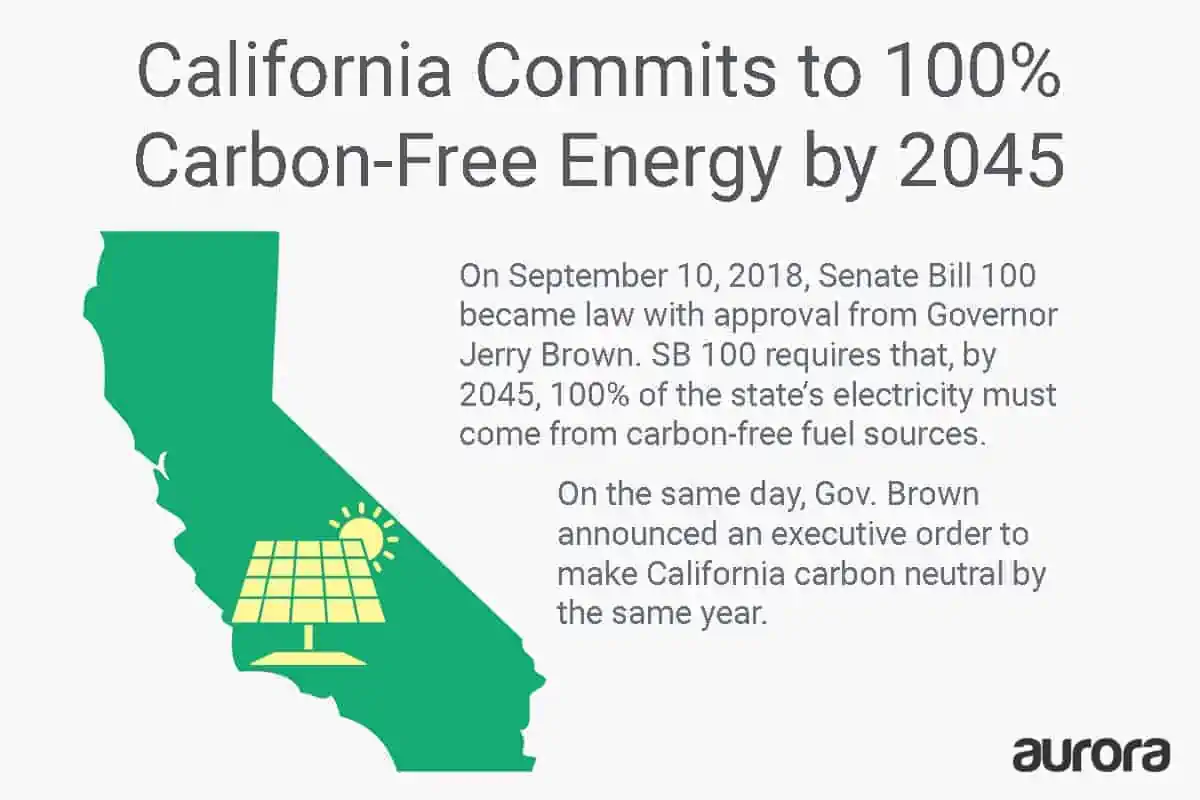
Colorado
Colorado became one of the first states to designate energy storage as a consumer right when Colorado Governor John Hickenlooper signed SB 18-009 into law in late March. The law states that residents should be able to install, use, and interconnect energy storage systems without unnecessary restrictions or discriminatory rates. It calls upon the Colorado Public Utilities Commission to establish rules governing customer-sited energy storage.
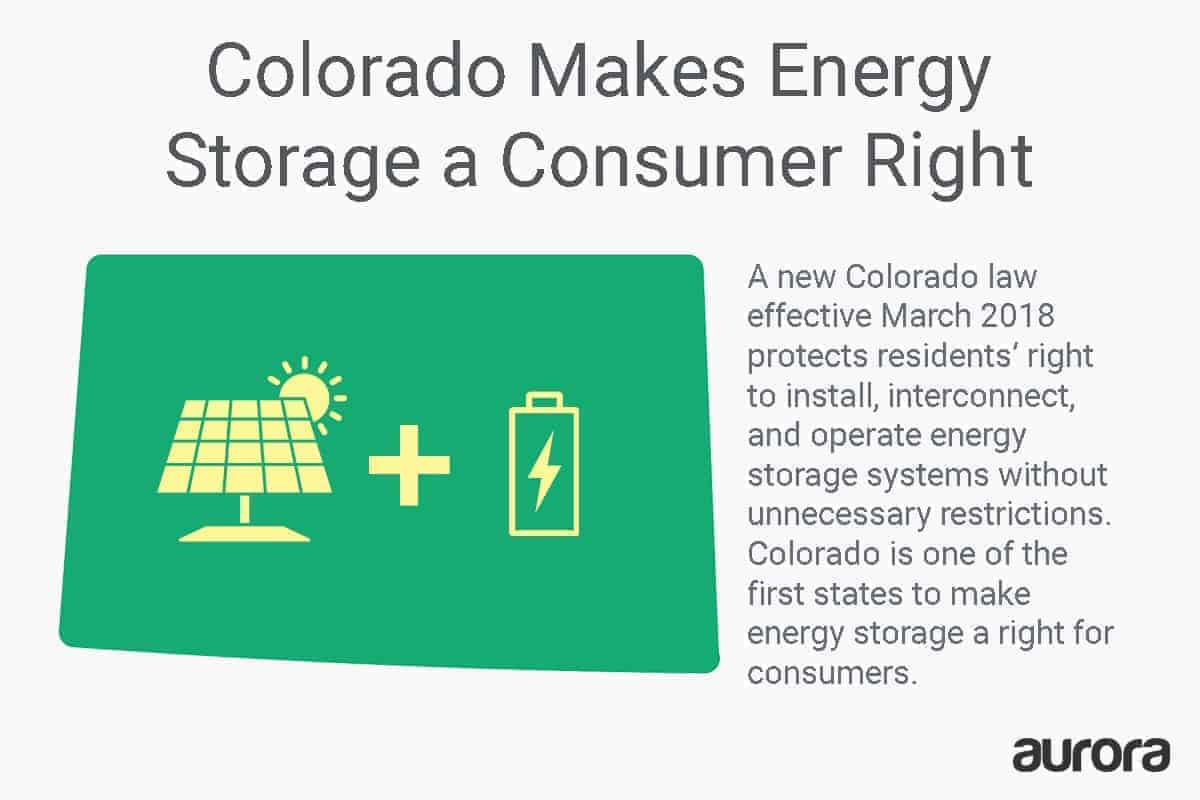
Florida
In a notable development for the Florida solar market, the Public Service Commission issued a statement in late April declaring that residential solar leases are allowed in the state. Previously, solar leases were deemed “third-party electricity sales,” which are prohibited in Florida.
Sunrun successfully argued to the commission that solar leases should be allowed because the payments are fixed and not contingent upon the amount of solar electricity the system produces. Florida solar customers now have a new financing option to choose from and solar companies in the state can offer a new product.

Hawaii
Hawaii is changing the revenue model for investor-owned electric utilities to better align their incentives with the growth of solar and energy storage. The measure, signed into law in April, is expected to aid the process of modernizing the state’s electricity grid because utility revenues will now be linked to performance metrics. The use of distributed energy resources like solar, rather than investment in costly new utility-owned infrastructure projects, will be incentivized.
This is big news. Utilities are a major player in the power sector, and their support or opposition is a major determining factor in solar market growth. Better aligning utility incentives with solar growth, as states like Hawaii and New York have endeavored to do, presents new opportunities for utilities to support the growth of renewable energy.
[Note: For related insights on how new revenue models for utilities can advance the growth of solar, see Aurora’s interview with Dr. Varun Sivaram.]

Additionally, in July, regulators ruled that existing solar customers in Hawaii who have net metering agreements (from prior to the state’s elimination of net metering in 2015), may now add energy storage systems without voiding the terms of their metering agreement.
Illinois
In April, Illinois regulators produced a plan to procure 25% of the state’s energy from renewable sources by 2025, as required under the Future Energy Jobs Act passed in 2016. Not only does the plan cover large investor-owned utilities, it also includes smaller, municipal utilities and rural electric cooperatives–which solar advocates say will make solar incentives more accessible to low-income and rural customers.
The policy impacts the state’s Renewable Portfolio Standard, which allows utilities to source some of their required renewable energy in the form of credits (Renewable Energy Certificates, including solar-specific SRECs) produced by renewable energy system owners. Under the new policy, Illinois existing SREC program is being updated.
The SREC program will now become an adjustable block rate program, in which solar will be compensated at a set flat rate (which declines as certain levels of installed capacity are hit), rather than a traditional SREC market where prices fluctuate based on market dynamics. Additionally, the SREC incentive program now lasts for 15 years, rather than the previous 5 year limit. The details of the program are still being finalized, but it will go into effect sometime in 2019.
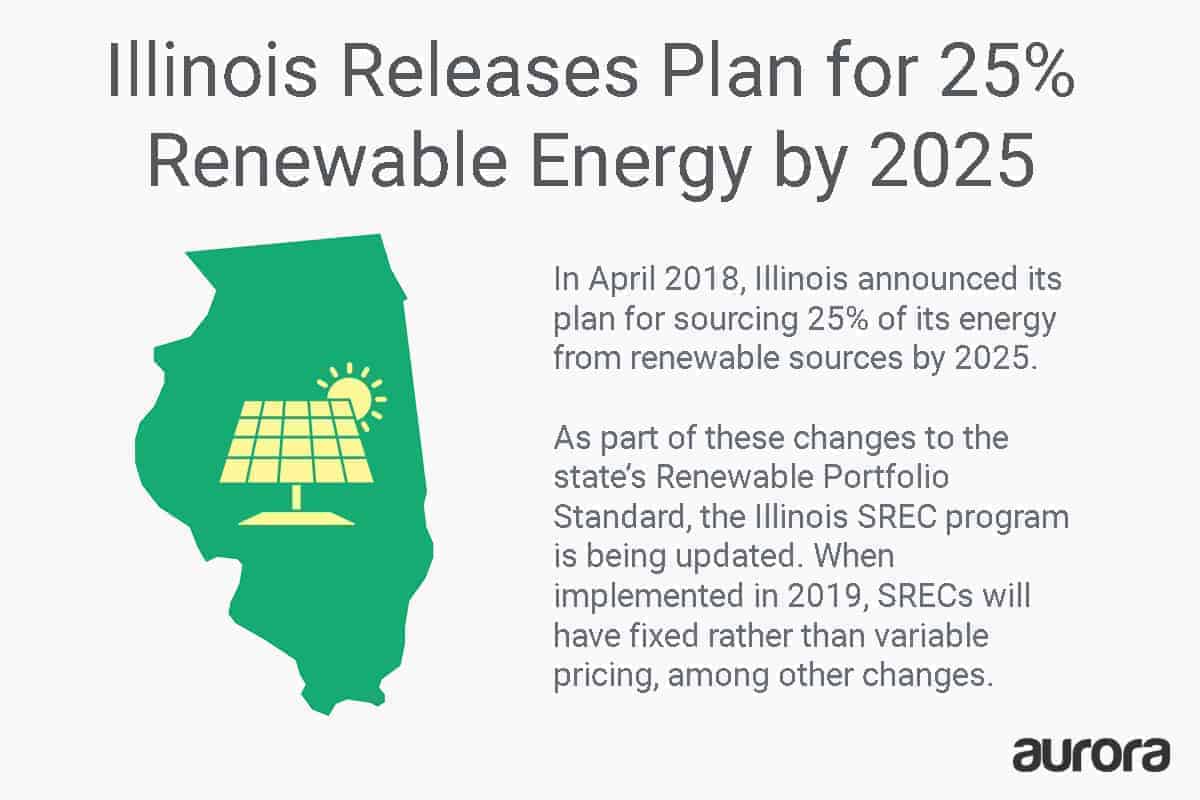
Maryland
In November, the Maryland Energy Administration launched a program to create “resiliency hubs,” powered by solar and energy storage, in disadvantaged communities. The program makes $5 million in grant funding available to solar and storage providers to help ensure low-income residents have access to basic services during power outages. The deadline for grant applications is March 1, 2019 and more information on the program can be found here.

Massachusetts
In October, the Massachusetts Department of Energy Resources approved compensation for owners of new solar projects under the state’s Solar Massachusetts Renewable Target (SMART) program, a successor to its previous SREC incentive program.
Like SRECs, the SMART program is a production-based incentive, meaning that PV system owners are compensated based on the amount of energy their system produces. Unlike the SREC program, however, system owners receive a fixed rate of compensation per unit of energy produced rather than being compensated a variable amount based on market demand.
The program is a declining block incentive program (similar to Illinois’ incentive program), where compensation rates will gradually decline over time as certain levels of installed capacity are reached. Applications for SMART compensation opened on November 26, 2018. Although compensation under this new program will be somewhat less than under the previous SREC program which had reached its limit, the program maintains incentives for solar customers and provides much-needed certainty to the industry.

New Jersey
The New Jersey solar industry also got good news this year. Governor Phil Murphy signed into law several key energy bills, including one that updates the state’s Renewable Portfolio Standard, requiring 35% of its power to come from renewables by 2025 and 50% by 2030. In addition, the law establishes the most ambitious solar-specific target in the nation, requiring that utilities source ~5% of their energy from distributed solar by 2021.
The law also includes a 600 MW energy storage target and establishes a community solar pilot program for the state. It also establishes a planned phase out of New Jersey’s SREC program in 2021 but calls on regulators to establish a successor program to support distributed New Jersey solar projects.
In other positive news for clean energy advocates, Governor Murphy also signed an executive order requiring the development of an Energy Master Plan providing a comprehensive plan for the state to reach 100% clean energy by 2050.
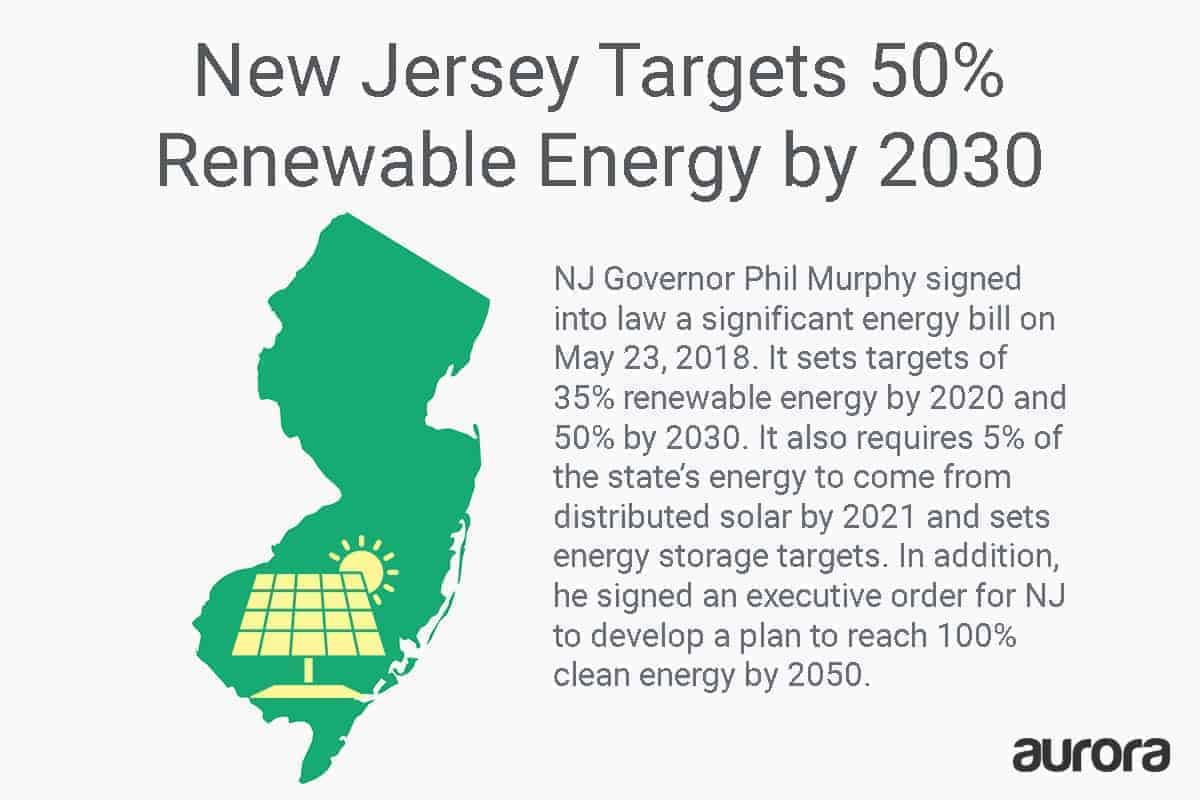
New York
In October, New York Governor Andrew Cuomo announced that the state will make $40 million of incentives available to support solar-plus-storage projects. The initiative is intended to advance New York’s existing commitments to source 50% of its electricity from renewable sources by 2030 and install 1500 MW of energy storage by 2025.
The funds will be available as part of New York’s existing Megawatt Block incentive program. Eligible projects with energy storage will be able to receive an additional incentive of $350 per kWh of installed storage capacity. Solar projects that have already been approved for the state’s existing incentives may be approved for these new incentives if they add energy storage.

Then, on December 17, 2018, Governor Cuomo pledged the state to 100% carbon-free electricity by 2040 in a speech announcing his policy agenda for early 2019. The move builds upon the state’s existing strong commitments to renewable energy.
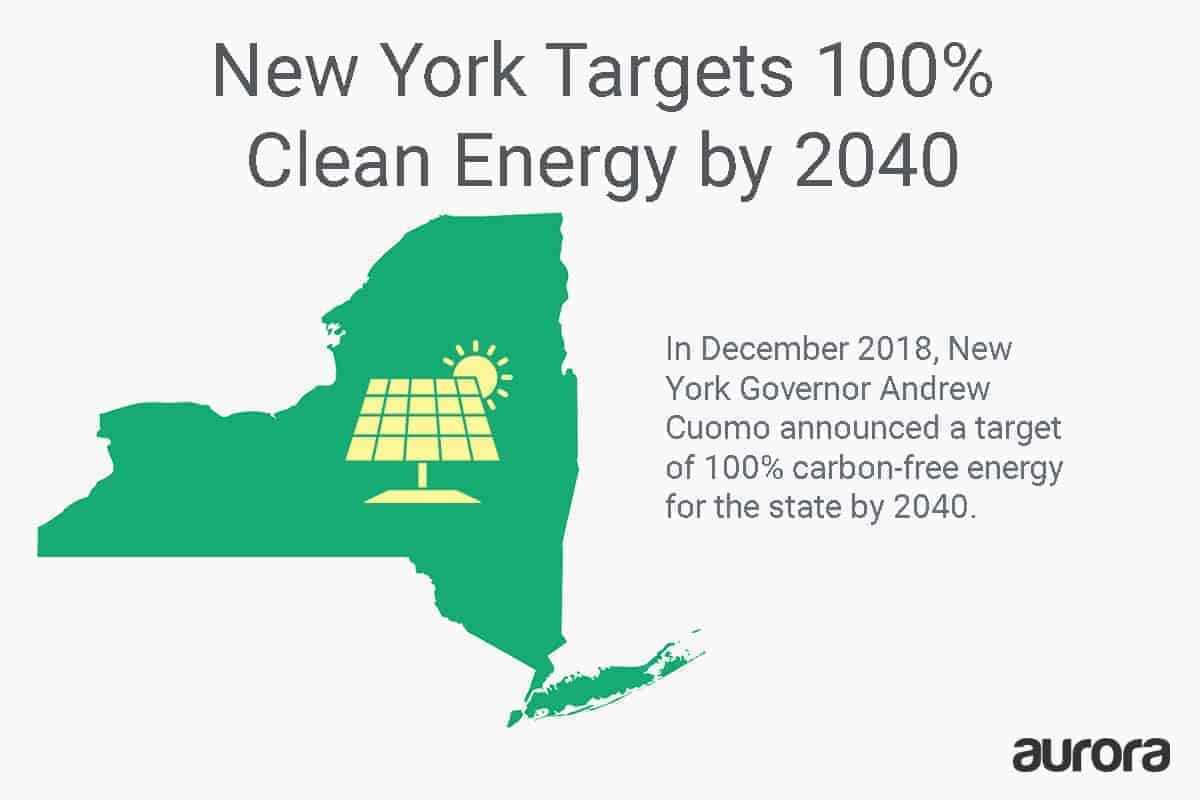
Nevada
In the midterm elections in November, Nevada voters approved a ballot initiative (”Question 6”) to increase the state’s Renewable Portfolio Standard (RPS) to require utilities to source 50% of their electricity from renewable energy by 2030. This is a significant increase from the state’s previous RPS which called for 25% renewables by 2025, and another great example of states leading the way on clean energy policy.
Nonprofit advocacy group Vote Solar worked to build support for the measure, and the Natural Resources Defense Council estimated that the policy could contribute to the creation of 11,170 full-time jobs and $1.5 billion in economic activity in 2030.

Pennsylvania
Pennsylvania has lagged behind neighboring states like New Jersey and Maryland in solar development. A new initiative announced by the Pennsylvania Department of Environmental Protection (DEP) may help change that.
Funded by a Sunshot grant from the U.S. Department of Energy, the state has initiated a 2-year planning process called “Finding Pennsylvania’s Solar Future” which is exploring approaches to provide 10% of the state’s energy from in-state solar by 2030, including changes to Pennsylvania’s Alternative Energy Portfolio Standards (it’s RPS).
A key output of the collaborative planning process is Pennsylvania’s Solar Future Plan, a set of recommendations released in November 2018 which includes 15 recommended strategies. The next step will be the development of an Implementation Report which will provide direction on how to implement the plan.
However the plan is implemented, it’s likely to be good news for the solar industry in Pennsylvania. The DEP predicts the plan could create between 60,000 and 100,000 new jobs, and as much as $1.6 billion in economic benefits annually.
Additionally, Governor Tom Wolf signed a bill earlier this year allowing commercial PACE (C-PACE) financing in the state, which would allow commercial property owners to repay solar loans via their property taxes, in municipalities that establish C-PACE programs.
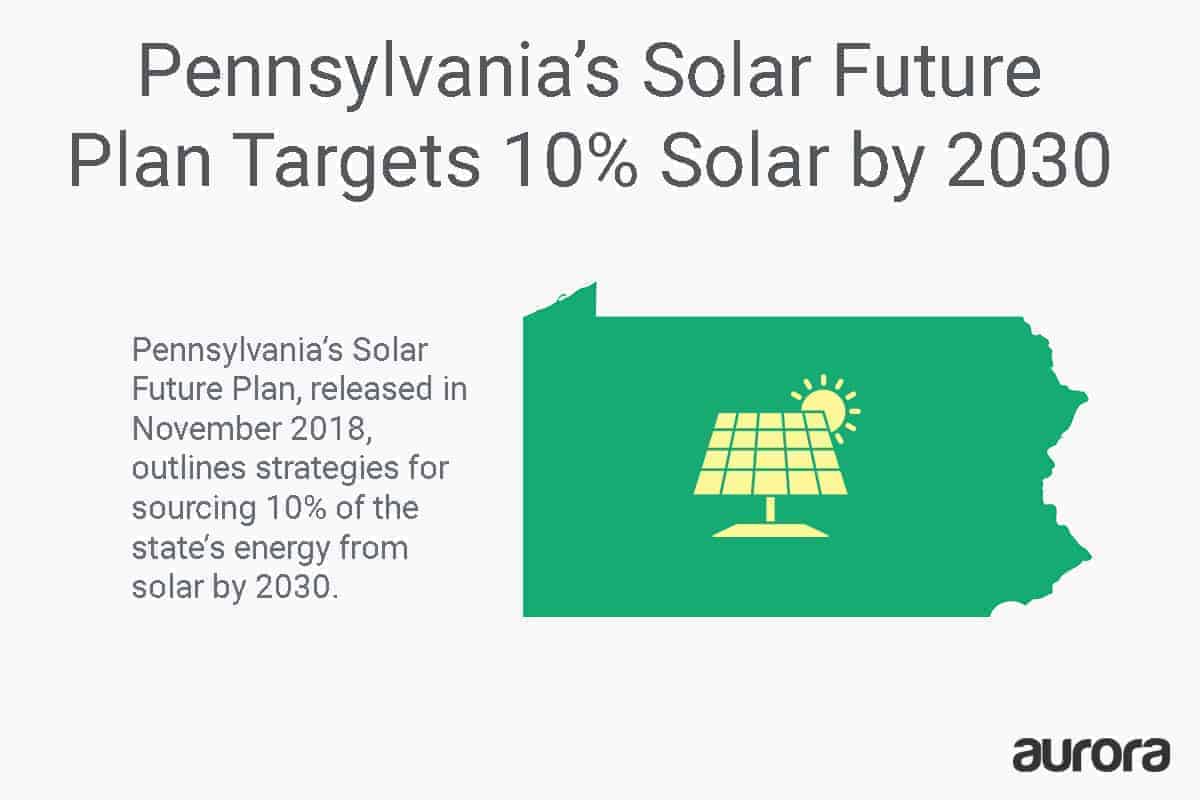
Utah
Two new policies with important implications for the Utah solar industry were signed into law by Utah Governor Gary Herbert in late March. One extends a $1,600 tax credit for residential Utah solar customers for an additional two years. The credit will begin to be phased out in 2021 over a period of three years. The other is a consumer protection measure that requires solar companies provide all residential customers with a disclosure statement to help ensure they understand the terms of their contracts. SEIA has applauded these developments.
These developments, particularly the tax credit, are welcome news for Utah’s solar industry since recent data show a slowdown in its rooftop solar market, likely stemming from a 2017 change to the state’s net metering approach.
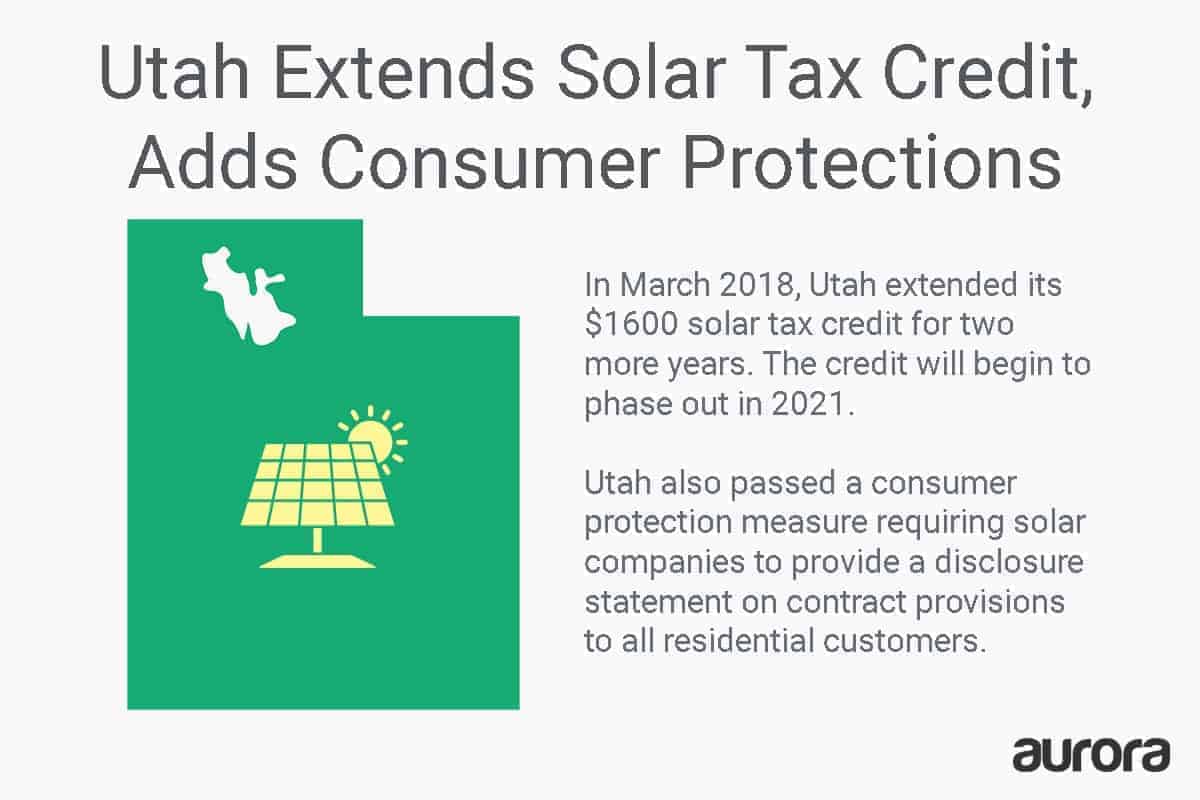
Virginia
The solar industry in Virginia is poised to surge as a result of its Grid Transformation & Security Act of 2018 which states, among other things, that 5000 MW of solar development by utilities is in the interest of the state. In October, Dominion Virginia Power issued a request for proposals (RFP) for 500 MW of solar projects, to be developed by 2020.
The projects may either be sold to Dominion or it will purchase the energy they produce through 20-year power purchase agreements. The resulting solar development will be utility-scale, with the minimum allowable project size being 5 MW.

Washington
On December 10, 2018 Washington Governor Jay Inslee released an ambitious clean energy proposal that addresses “five policy goals: 100% clean energy by 2045, transitioning to electric transportation, adding a clean fuel standard, constructing energy efficient buildings and eliminating hydrofluorocarbon.” As part of the transition to 100% clean energy, coal-fired power plants would be phased out by 2025. The proposal also calls for the reduction of over 80 million metric tons to limit them to 25% below 1990 levels by 2035.

The Bad News
Connecticut
Despite vocal opposition from the Connecticut solar industry, the state recently eliminated net metering for solar customers. The bill, which advocacy groups had decried as a serious threat to 2000+ Connecticut solar jobs was signed into law by Governor Dannel Malloy in June.
As written, the policy would set a new flat rate for solar compensation, though the exact structure that will be implemented remains to be seen. The decision now goes to the state Public Utilities Regulatory Authority for review and rate setting. One bright spot in the bill is that it establishes a target of 40% renewable energy by 2030 under the state’s renewable portfolio standard by 2030.

Kansas
While many states took steps to advance the growth of the solar industry, Kansas took a step back this year. In September, Kansas regulators approved a new charge that only applies to solar customers of the state’s largest electric utility, Westar Energy. The demand fee–of $9 per kilowatt in summer and $3 per kilowatt at other times of the year–is expected to cancel out the savings for many smaller solar projects, reports Midwest Energy News. The fee will apply to solar systems installed in 2015 and later, including new systems.
Demand charges, while common for commercial customers, have historically been rare for residential customers (though Massachusetts also applied residential demand charges this year, as discussed below).These charges are based on the maximum amount of energy the customer used during any (usually 15-minute) interval during the month. They are very difficult for customers to control and, as we discuss in a commercial case study, can significantly reduce solar savings.
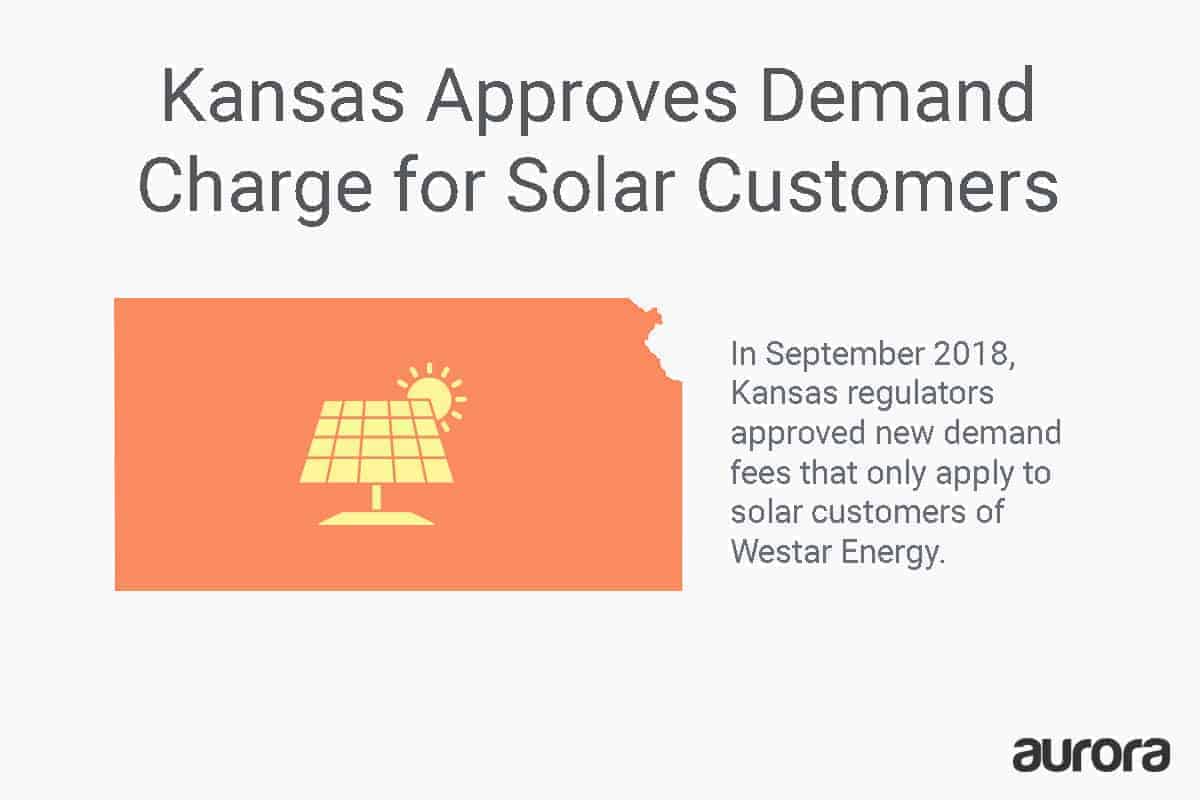
Massachusetts
In one of the first blows to solar energy this year, Massachusetts approved new charges for new solar customers in January. At the same time, the state became the first in the nation to approve demand charges for all residential net metering customers starting in 2019, a “charge without a cause” according to industry groups.
A bill passed by the Massachusetts Senate in June raised hopes that the demand charge might be repealed. Unfortunately, the version ultimately agreed upon by the House and Senate and signed into law by Governor Charlie Baker on August 9th, did not contain the repeal language. It upholds the charges, stating that a ”distribution company may assess a demand charge if it is based on system peak demand during the hours of a day determined to be peak hours of system demand and if the distribution company regularly informs affected customers of the manner in which demand charges are assessed and of ways in which said customers might manage and reduce demand.”

Michigan
Michigan dealt a serious blow to solar by eliminating net metering. In late April, the Michigan Public Service Commission elected to replace net metering with a new approach. Under this policy, solar customers will buy energy from the grid at the retail rate but be compensated for the solar energy they send to the grid at a significantly lower rate. That rate will be based on an estimate of how much the utility would otherwise pay to procure that power, an “avoided cost” calculation. Fortunately, current Michigan net metering customers will retain their current rates for 10 years, but the shift is a big loss for future Michigan solar customers.
[Note: For an overview of related trends, check out Aurora’s blog post on how net metering is changing—and being scaled back—around the country.]
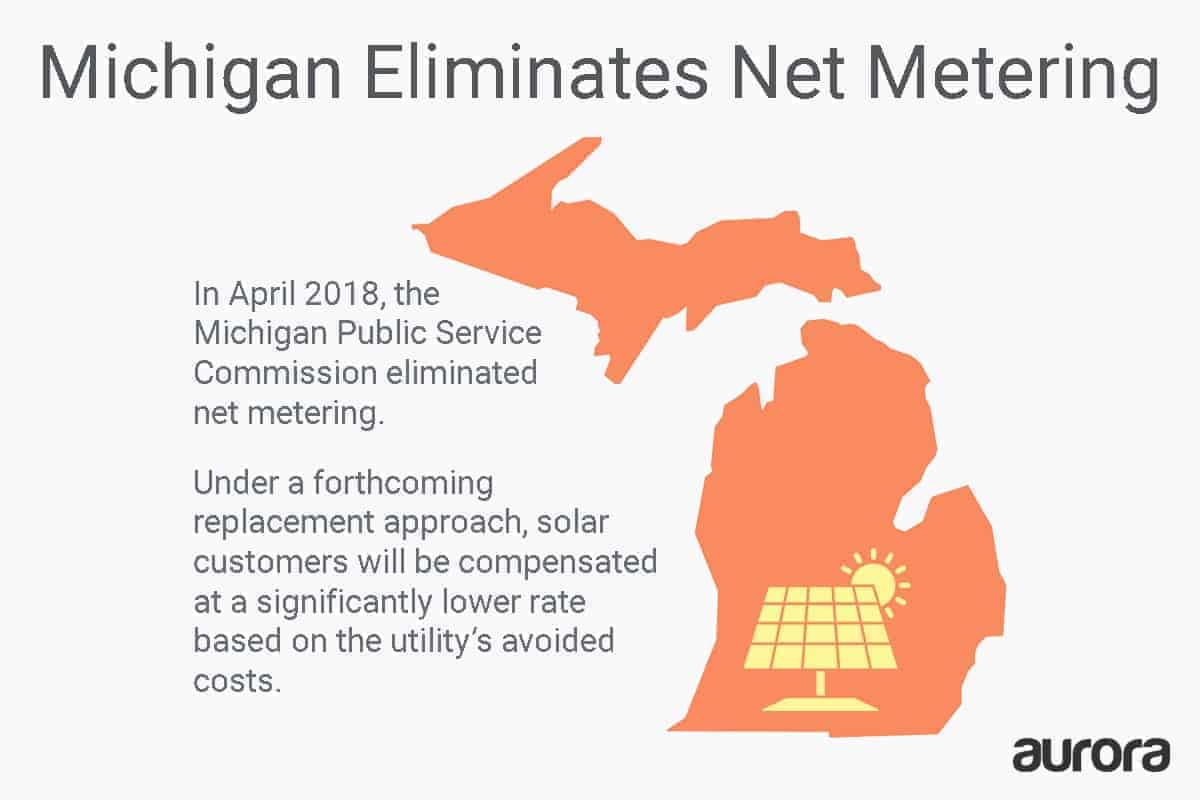
Although not all of the state policy changes to date this year were favorable for solar, it’s great to see so many states recognizing the value of solar and working to make it more accessible. We’re excited to see how solar continues to grow in the coming year!
Are there policy developments we missed? Let us know in the comments below!